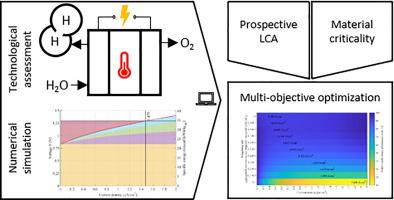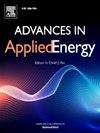Hydrogen production via solid oxide electrolysis: Balancing environmental issues and material criticality
IF 13.8
Q1 ENERGY & FUELS
引用次数: 0
Abstract
Hydrogen is considered an essential component in mitigating climate change. Water electrolysis technologies present the potential for generating environmentally friendly hydrogen. The solid oxide water electrolysis attracts attention due to its high-temperature operation, leading to an unsurpassed efficiency. Nevertheless, high-temperature operation requires special materials, raising material criticality concerns. This study aims to determine the optimum current density for future solid oxide water electrolysis operation. To this end, the energetic performance of solid oxide electrolysis is assessed under different current densities with a numerical simulation. Consequently, prospective life cycle assessments and product-level material criticality assessments are performed. These dimensions are combined in a multi-criteria optimization. The environmental impacts strongly depend on electricity and heat generation, whereas manufacturing and the feed water supply play a minor role. Heat integration, a unique feature of solid oxide water electrolysis, is beneficial if heat carries less environmental impact than electricity. Then, the solid oxide electrolysis should be operated at relatively low current densities. In contrast, the material criticality decreases with increasing current densities. The multi-criteria optimization reveals that if minimizing environmental impacts and material criticality is equally vital, solid oxide water electrolysis should be operated at 0.955 A/cm2, whereas a focus on environmental impacts leads to lower current densities. In conclusion, the energy supply situation affects the operational current density from an environmental perspective. In contrast, the material criticality favors high current densities for solid oxide water electrolysis. When combining both, medium current densities lead to minimum environmental and material criticality issues.

通过固体氧化物电解生产氢气:平衡环境问题和材料关键性
氢被认为是减缓气候变化的重要组成部分。水电解技术为生产环保型氢气提供了潜力。固体氧化物水电解技术因其高温运行、无与伦比的效率而备受关注。然而,高温运行需要特殊材料,从而引发了材料临界问题。本研究旨在确定未来固体氧化物电解水操作的最佳电流密度。为此,通过数值模拟评估了不同电流密度下固体氧化物电解水的能量性能。因此,还进行了前瞻性生命周期评估和产品级材料临界度评估。这些方面结合在一起进行了多标准优化。对环境的影响在很大程度上取决于发电和制热,而生产和给水供应所起的作用较小。如果热能对环境的影响小于电能,那么热能集成(固体氧化物电解水的一个独特功能)就会带来好处。那么,固体氧化物电解应该在相对较低的电流密度下运行。相反,材料临界度会随着电流密度的增加而降低。多标准优化结果表明,如果环境影响最小化和材料临界度同样重要,则固体氧化物电解水应在 0.955 A/cm2 下运行,而注重环境影响则会导致较低的电流密度。总之,从环境角度来看,能源供应情况会影响运行电流密度。相比之下,材料临界性有利于固体氧化物电解水的高电流密度。将两者结合起来,中等电流密度可将环境和材料临界问题降至最低。
本文章由计算机程序翻译,如有差异,请以英文原文为准。
求助全文
约1分钟内获得全文
求助全文

 求助内容:
求助内容: 应助结果提醒方式:
应助结果提醒方式:


